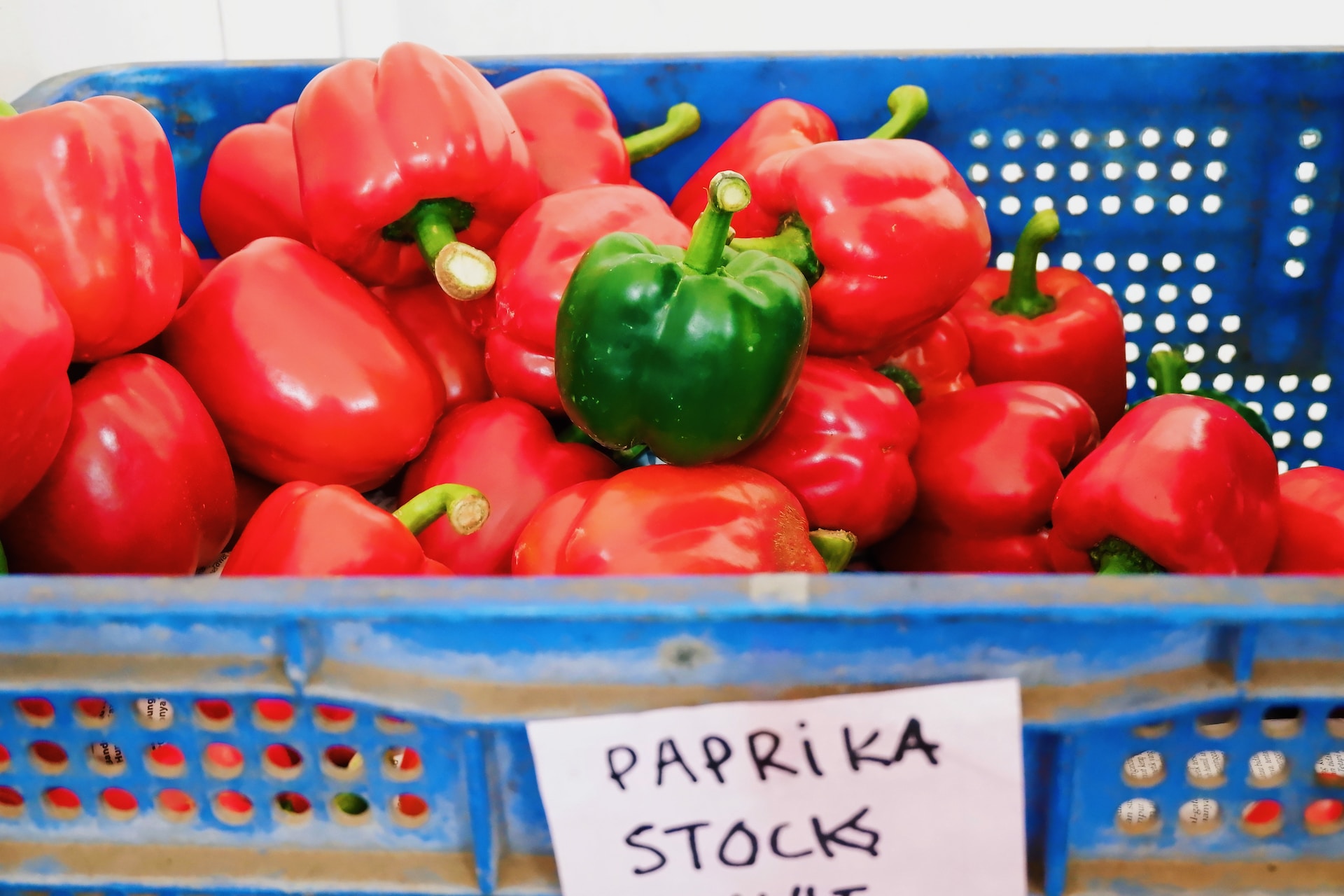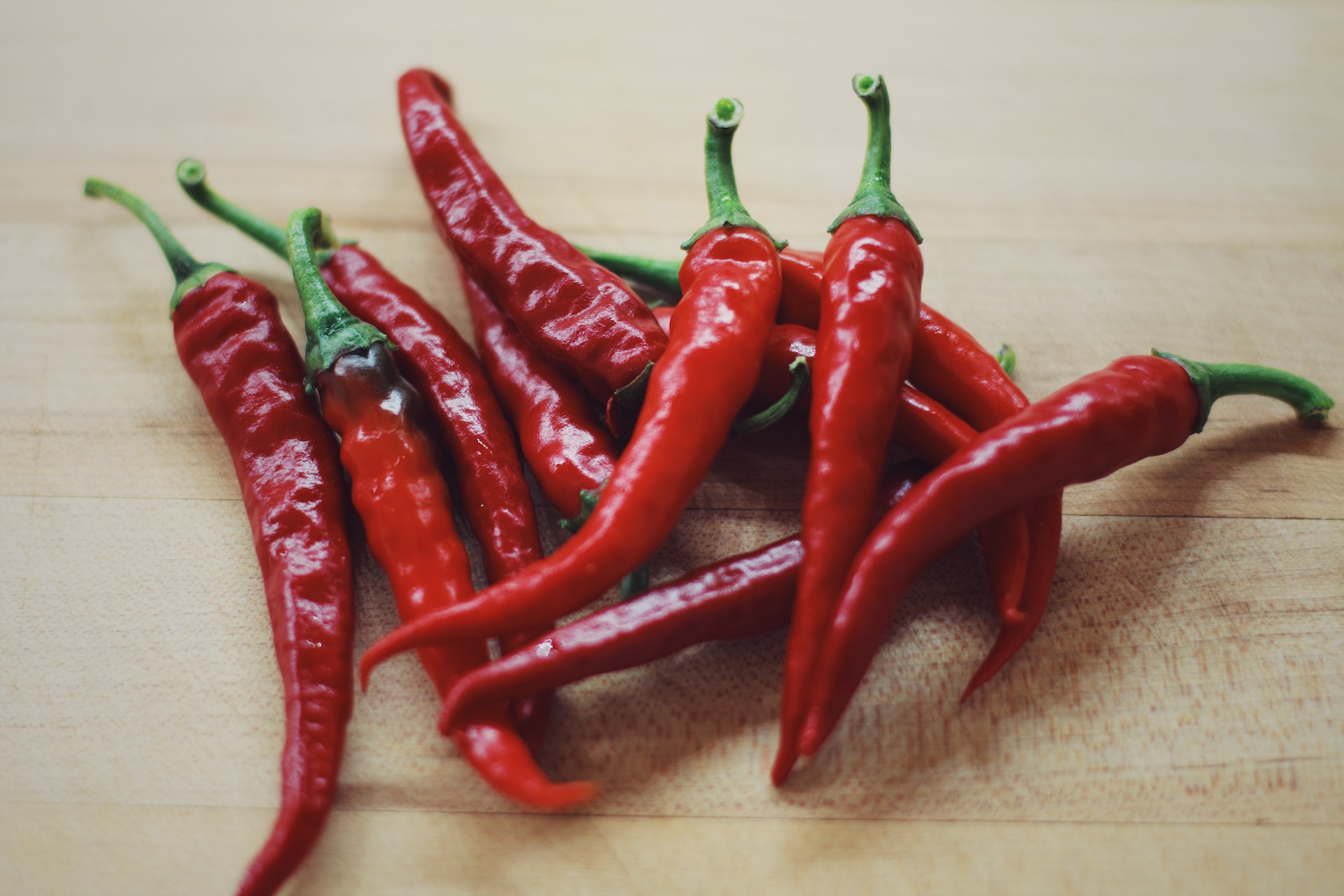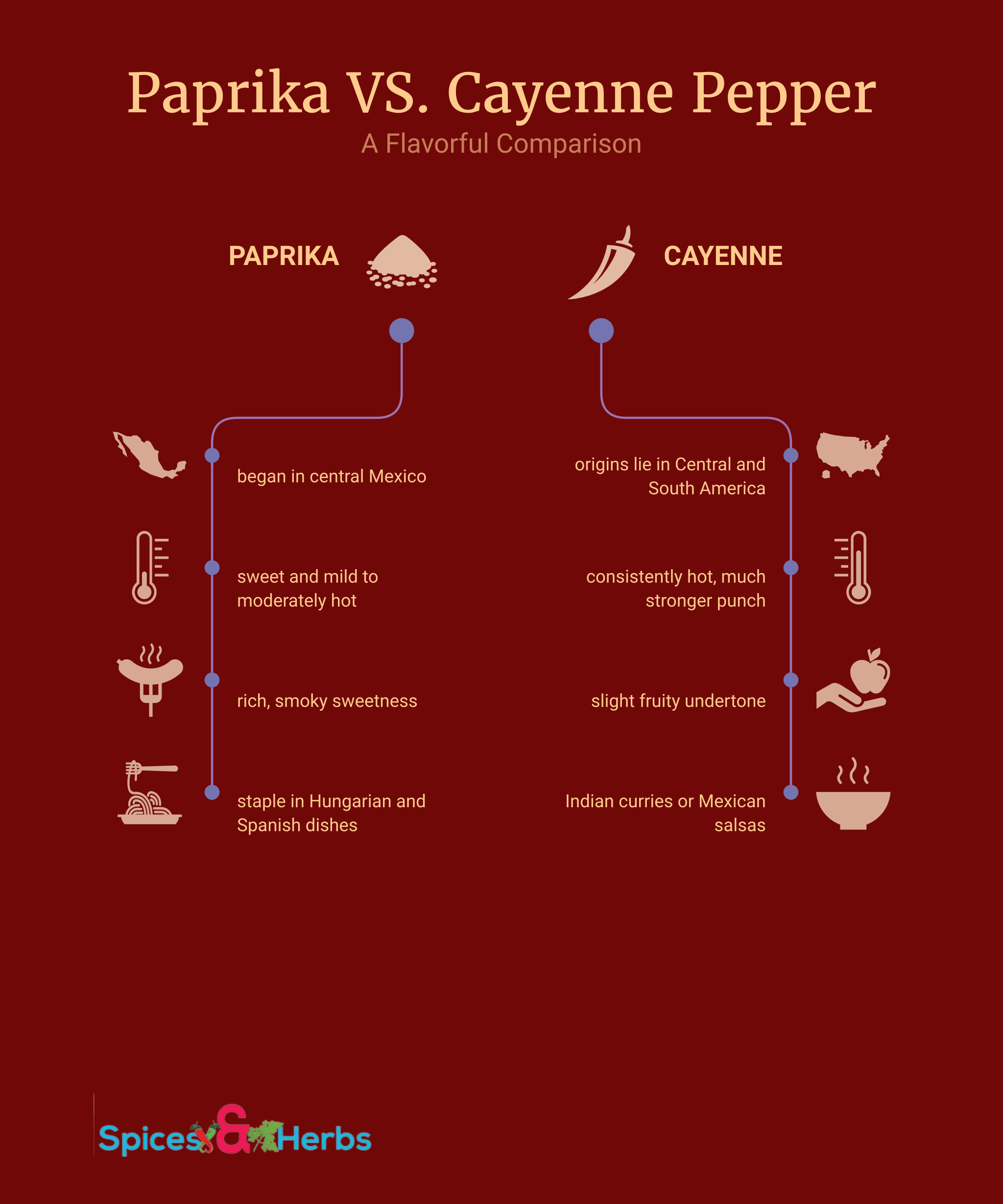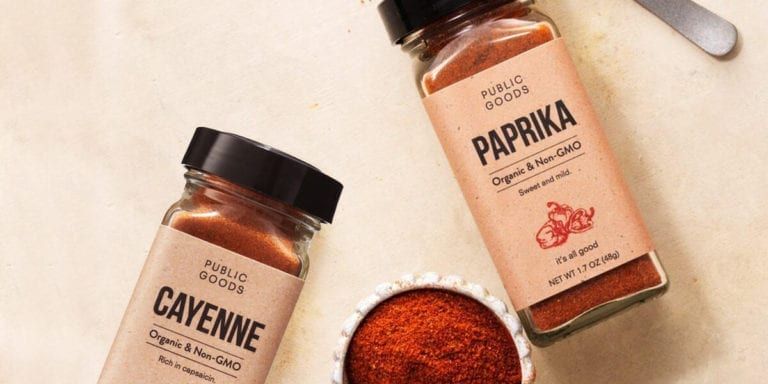As a home cook, I know how crucial it is to pick the right spices for every dish. It’s like creating a symphony where every ingredient plays its part in harmony with others. One common dilemma I often face, and you might have too, revolves around two fiery characters in our spice rack: paprika and cayenne pepper.
Understanding this “paprika vs. cayenne pepper” debate is like unraveling a culinary mystery. The spices come from the same pepper family but have unique identities. They both add heat and flavor to our dishes, but using one instead of the other can dramatically alter the taste of our food.
Why is it important to know the difference? Well, imagine you’re preparing a traditional Hungarian goulash that calls for the sweet smokiness of paprika, but you replace it with the intense heat of cayenne pepper. The result might still be delicious, but it won’t be the authentic goulash experience you were aiming for. So, let’s dive in and explore the fascinating world of these two spices.
Paprika: A Spice Like No Other

Paprika is a ground spice derived from certain members of the Capsicum annuum species of red peppers. The color of paprika pepper can range from a bright, fiery red to a more subdued orange-red, depending on the variety of chili peppers used. Its flavor can vary from sweet and mild to hot and smoky.
For instance, if you’re cooking a Spanish paella, you’d probably reach for the sweet paprika, which adds a subtle depth without overpowering the dish. However, if you’re making a hearty Hungarian goulash, you might prefer the hot version for that extra kick.
❣The Historical Journey of Paprika
To truly appreciate paprika, it’s essential to understand its rich history. The story of paprika began in central Mexico, where the indigenous people had been cultivating peppers for thousands of years. When Christopher Columbus embarked on his second voyage to the New World in the late 15th century, he encountered these peppers. Fascinated, he brought them back to Spain, where they used them as decorative plants.
However, it didn’t take long for the Spanish to recognize the culinary potential of these peppers. They began drying and grinding them into a powder, thus creating the first version of what we now know as paprika. The spice quickly gained popularity across Europe, particularly in Hungary, where it became a staple ingredient in national dishes.
Interestingly, while paprika has a long history in Spanish and Hungarian cuisines, it wasn’t until the 19th century that it became widely recognized in these cultures. For example, the lower classes initially associated themselves with spice in Hungary. It was only when a disease wiped out most black pepper crops (a spice favored by the nobility) that paprika found its way into the pots and pans of the upper class, eventually becoming a symbol of Hungarian cuisine.
❣The Cultivation and Production Process
The journey of paprika from a simple pepper to the vibrant red powder that adorns our dishes is fascinating. The cultivation process begins with sowing pepper seeds in a warm, sunny environment. Once the peppers ripen, usually turning a brilliant shade of red, farmers harvest them.
After harvesting, they sort the peppers and remove the stems and seeds. What follows is a crucial step that defines the flavor profile of the resulting spice – drying. The peppers can be sun-dried, slowly dehydrated over several days, or smoked, giving the paprika its distinctive smoky flavor. In some regions, like La Vera in Spain, peppers are dried over wood fires, infusing them with a deep, smoky aroma.
The manufacturers grind the thoroughly dried peppers into a fine deep red chili powder. They do the grinding process carefully to avoid heat generation, which can degrade the color and flavor of the spice. The resulting paprika powder is then packaged and sent to markets worldwide, ready to add color and flavor to many dishes.
❣The Varieties of Paprika
Paprika isn’t a one-note spice. It comes in various types, each with its unique flavor profile and heat level. Understanding these varieties can help you make the most of this versatile spice in your cooking. Here are a few of the most popular ones:
Sweet Paprika: Also known as Hungarian Sweet Paprika, this variety is mild and sweet, with a rich, full-bodied flavor. It’s perfect for dishes that need a touch of warmth without a spicy kick, such as deviled eggs or potato salad.
Hot Paprika: As the name suggests, this type packs a punch. This Paprika hotter and spicier than its sweet counterpart, making it ideal for dishes that require a bit of heat, like a robust Hungarian goulash.
Smoked Paprika: This variety, also known as Pimentón de la Vera, is dried over wood fires, giving it a deep, smoky flavor. It’s a star ingredient in Spanish dishes like paella and chorizo sausage.
Spanish Paprika: Also known as Pimentón, this Paprika comes in three varieties – dulce (sweet), agridulce (bittersweet), and picante (hot). Spanish cuisine uses These varieties extensively, adding depth and warmth to dishes.
Each variety of paprika brings something unique to the table. So, whether you’re looking for a subtle sweetness, a fiery kick, or a smoky depth, there’s a paprika out there for you.
❣Understanding Paprika’s Flavor Profile and Heat Level
Paprika’s flavor profile is as vibrant as its color. The taste can range from sweet and mild to hot and smoky, depending on the type of paprika. Sweet paprika, often used in Hungarian cuisine, has a rich, full-bodied flavor, subtle sweetness, and a hint of fruitiness. You’ll often find this variety sprinkled on dishes for a pop of color and a gentle warmth.
Hot paprika, on the other hand, brings a noticeable heat. While not as fiery as cayenne pepper or chili powder, it still provides a significant kick that enlists any dish. Then there’s smoked paprika, a favorite in Spanish cuisine, which adds a deep, smoky flavor that pairs exceptionally well with meats and hearty stews.
Regarding heat level, paprika is generally considered mild to medium. However, it’s essential to remember that “hot” paprika can be pretty spicy, so use it sparingly if you’re sensitive to heat.
❣The Health Benefits of Paprika
Paprika isn’t just a flavor enhancer; it’s also packed with health benefits. This vibrant spice is rich in vitamins and minerals, particularly Vitamin A, which supports eye health, and Vitamin E, which has antioxidant properties.
Paprika is also known for its anti-inflammatory properties. Capsaicin, which gives peppers their heat, has reduced inflammation, making paprika a potentially beneficial addition to a diet for those with inflammatory conditions.
Moreover, the capsaicin in paprika can help boost your metabolism. Some studies suggest that capsaicin can increase the amount of heat your body produces, making you burn more calories per day.
Lastly, paprika is rich in iron, which aids in the formation of red blood cells. A sprinkle of paprika on your meals could prevent anemia and boost overall energy levels.
So, while we savor the unique flavors that paprika brings to our dishes, it’s comforting to know that this remarkable spice also contributes to our well-being.
Cayenne Pepper: A Fiery Delight

Cayenne pepper is a type of Capsicum annuum, encompassing many pepper varieties. What sets Cayenne apart from its cousins is its heat. While peppers like bell peppers and jalapenos can vary widely in their heat levels, cayenne peppers are consistently hot. They’re long, thin, and usually red, although you may also find them in yellow and purple.
The spice we call cayenne pepper is made by grinding the dried pods of the pepper into a fine powder. This results in a spice that is both hot and slightly sweet, with a hint of fruitiness. This unique combination makes cayenne pepper so versatile, adding depth and heat to everything from a simple pot of red chili pepper to an elaborate curry.
🌶The History of Cayenne Pepper
Cayenne pepper gets its name from the city of Cayenne in French Guiana, but its origins lie in Central and South America. For thousands of years, indigenous peoples have cultivated these fiery peppers, using them to add heat to their food and for medicinal purposes.
Like paprika, cayenne pepper was brought to Europe by Christopher Columbus. From there, it spread rapidly across the globe, finding its way into cuisines from Asia to Africa and beyond. Today, cayenne pepper is a staple in many world cuisines, celebrated for its ability to turn up the heat and enhance other flavors in a dish.
🌶The Cultivation and Production
Cayenne pepper powder thrives in a warm, sunny climate. The seeds are planted in well-drained soil and need plenty of sunlight. After about 100 days, the peppers ripen to a vibrant red color, signaling they’re ready to be harvested.
After harvesting, the harvesters dry the peppers to preserve their flavor and heat. They do this in the sun, in a dehydrator, or even in an oven. Once fully dried, they grind the peppers into a fine cayenne powder. The manufacturers must do this process carefully to ensure the heat doesn’t degrade the spice’s flavor or color.
The result is a fiery red powder ready to take your dishes to the next level. So, whether sprinkling it on your morning eggs or spicing up your favorite soup, remember this humble pepper’s journey from the field to your kitchen.
🌶The Varieties of Cayenne Pepper
While we often think of cayenne pepper as a single spice, there are several varieties, each with its unique level of heat and flavor. Some of the most popular types include the African Birdseye, typically used in Peri-Peri sauce; the super-hot Thai Cayenne, a staple in Thai cuisine; and the milder American variety, commonly used in sauces and stews across the United States.
Each variety has unique characteristics, but they all share the signature heat that cayenne peppers are known for. So whether you’re adding a pinch to your pasta sauce or using it to fire up your stir-fry, there’s a cayenne pepper out there to meet your culinary needs.
🌶Understanding Cayenne Pepper’s Flavor Profile and Heat Level
Cayenne pepper is known for its intense heat, but there’s more to this spice than just its fiery kick. Beneath the heat, Cayenne has a slightly fruity, mildly sweet flavor that can add depth to a wide range of dishes. This balance of heat and flavor makes Cayenne such a versatile spice.
In terms of heat level, cayenne pepper is considered medium to hot. It falls between 30,000 to 50,000 on the Scoville Heat Scale, a measurement of red peppers’ pungency (spiciness or “heat”). It makes it significantly hotter than jalapenos and most types of paprika but not as hot as habanero or ghost peppers.
🌶The Health Benefits of Cayenne Pepper
Like paprika, cayenne pepper isn’t just a flavor powerhouse; it’s also packed with health benefits. Its active compound, capsaicin, has been linked to several health benefits.
For starters, capsaicin is known to boost metabolism. It does this by increasing the body’s heat, making you burn more calories throughout the day. It can help support weight loss goals alongside a balanced diet and regular exercise.
Capsaicin also has potent pain-relieving properties. It can reduce the amount of substance P, a chemical that carries pain messages to the brain in your body. It is why you’ll often find capsaicin in topical creams and patches for arthritis and muscle pain.
Cayenne pepper is rich in vitamins A, E, C, B6, and K, as well as potassium and manganese. These nutrients support overall health, aiding everything from eye health to immune function.
So, while cayenne pepper might make you sweat a little, remember it’s also doing your body well!
Paprika vs. Cayenne Pepper: A Comparison

Now that we’ve explored the individual journeys of paprika and cayenne pepper, it’s time to bring them head-to-head in a flavorful face-off. While they both hail from the same Capsicum annuum family and add heat and color to our dishes, these two spices have distinct characteristics that set them apart. Let’s delve into their similarities and differences.
💞Similarities between Paprika and Cayenne Pepper
At first glance, paprika and cayenne pepper share quite a few similarities. Both are ground spices derived from members of the Capsicum annuum species. They both add vibrant red color to dishes, making them visually appealing.
In terms of flavor, both paprika and cayenne pepper can add a level of heat to dishes, although the intensity varies. They both have a slightly sweet undertone, adding depth and complexity to the foods.
Moreover, Paprika vs Cayenne health benefits are obvious, thanks to their rich content of vitamins, minerals, and beneficial plant compounds. They’re both known for their anti-inflammatory properties and potential to boost metabolism.
💞Differences between Paprika and Cayenne Pepper
Despite these similarities, paprika and cayenne pepper are far from interchangeable. One of the most significant differences lies in their heat level. While paprika ranges from sweet and mild to moderately hot, cayenne pepper is consistently hot, packing a much stronger punch.
The flavor profiles of these two spices also differ. Paprika has a rich, smoky sweetness (especially the smoked variety), while cayenne pepper offers a more straightforward heat with a slight fruity undertone.
Furthermore, while many people use both spices worldwide, they each hold a special place in different cuisines. Paprika is a staple in Hungarian and Spanish dishes, such as goulash and paella. Meanwhile, you can find cayenne pepper in spicy dishes from various cuisines, like Indian curries or Mexican salsas.
So, while paprika and cayenne pepper can spice up your meals, knowing their differences can help you choose the right spice for the dish. Whether you’re craving the smoky sweetness of paprika or the fiery kick of cayenne pepper, both spices have a unique place in the culinary world.
Tips for Cooking with Paprika and Cayenne Pepper
Cooking with spices like paprika and cayenne pepper can elevate your dishes to new culinary heights. However, to truly unleash their potential, it’s important to understand how to store, use, and balance these spices in your recipes. Let’s explore some tips to help you become a master of cooking with these flavorful spices.
🍛Storing and Using Paprika and Cayenne Pepper Properly
Proper storage is crucial to keep your paprika and cayenne pepper fresh and flavorful. You should keep both spices in airtight containers in a cool, dark place. Exposure to heat, light, and air can degrade the flavor and color of the spices over time.
When using these spices, it’s best to add them early in the cooking process. It allows their flavors to meld with the other ingredients and infuse the entire dish. However, be careful not to cook them on high heat for too long, as they can burn and turn bitter. If you’re sprinkling them on a dish as a finishing touch, do so just before serving to maintain their vibrant color and taste.
As with any spice, start with a small amount and adjust to taste. Remember, adding more heat than taking it away is easier!
🍛Balancing Spiciness in Your Dishes
While the heat from paprika and cayenne pepper can excite your dishes, it’s important to keep it balanced. Too much heat can overpower the other flavors in your dish.
If you find that you’ve added too much spice, don’t panic. There are several ways to tone down the heat. Adding a sweet component, like honey or sugar, can help balance the spiciness. Dairy products, like milk or yogurt, can also counteract the heat thanks to casein, a protein that binds with capsaicin (the compound that gives peppers their heat) and washes it away.
Another tip is to pair spicy dishes with cooling elements. For instance, if you’ve made a fiery curry with cayenne pepper, serve it with a cucumber raita or a dollop of plain yogurt to help balance the heat.
Frequently Asked Questions
Q: Can I use Cayenne Pepper as a substitute for paprika?
A: Yes, you can use cayenne pepper as a substitute for paprika, but remember that cayenne pepper is significantly hotter than most types of paprika. If you’re substituting cayenne pepper, start with about half the amount of paprika called for in the recipe and adjust to taste.
Q: What dishes are best for Paprika and Cayenne Pepper?
A: Paprika is a staple in Hungarian and Spanish cuisines, often used in dishes like goulash, paella, and chorizo. It also adds color and mild heat to dishes like deviled eggs, roast chicken, and potato salad. On the other hand, Cayenne pepper is perfect for adding a kick to a wide range of dishes, from curries and soups to stews and hot sauces. It’s also a key ingredient in spice blends like Cajun and Creole seasoning.
Q: Are there any health risks associated with these spices?
A: Paprika and cayenne pepper are generally safe to consume in normal food. However, if consumed in large quantities, the capsaicin in these spices can cause stomach upset, sweating, flushing, and runny nose. People with gastrointestinal disorders should be cautious as these spices may aggravate symptoms. As always, it would be best to consult with a healthcare professional if you have any concerns or specific dietary restrictions.
Final Words
While paprika and cayenne pepper share a common family tree, both adding a burst of color and heat to our dishes, they each have unique characteristics. From paprika’s sweet and smoky flavor to the fiery kick of cayenne pepper, these spices can transform your culinary creations differently. We’ve also learned that they’re not just about taste and heat. They come with an array of health benefits too.
Understanding the differences between these two spices is crucial in mastering their use in the kitchen. Knowing their distinct flavor profiles and heat levels allows you to choose the right spice for your dish, bringing out the best flavors and creating a balanced heat that suits your taste buds. So next time you reach for that spice rack, remember the journey these spices have taken from seed to your kitchen and the unique qualities they bring to your plate.
Now it’s your turn to experiment! We’d love to hear about your experiences cooking with paprika and cayenne pepper. What are your favorite recipes using these spices? Have you discovered any tips or tricks for using them? Leave a comment below, and let’s continue this flavorful conversation.

